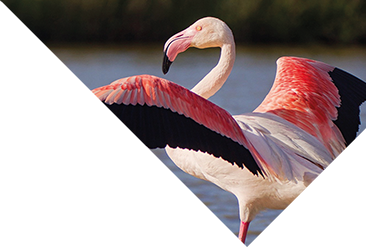| Name of the course |
ECTS credits |
Semester |
Lectures |
Tutorials |
Practicals |
| Evolutionary Biology |
6 |
1 |
24h |
16h |
10h |
| Biologie des Populations et des Communautés (course in French) |
6 |
1 |
24h |
12h |
14h |
| Biometry |
6 |
1 |
20h |
12h |
18h |
| Quantitative ecology, data analysis and modeling |
6 |
1 |
24h |
16h |
10h |
| Behavioural Ecology and Symbiotic Interactions |
6 |
1 |
33h |
12h |
5h |
| Conservation Biology and Ecosystem Management |
6 |
2 |
30h |
10h |
10h |
| Behavioural Ecology: proximate and ultimate aspects |
6 |
2 |
30h |
20h |
– |
| Behavioural Ecology: applications to conservation and wildlife management |
6 |
2 |
25h |
10h |
15h |
| Internship (2 months) |
12 |
2 |
– |
– |
100h |
Program outline :
♦ Teaching unit S1 Evolutionary Ecology
Lectures:
o A brief history of Evolutionary Biology
o Measuring natural selection in the wild
o Evolutionary process driving biodiversity
o The study of adaptation
o The extended evolutionary synthesis – Epigenetic inheritance
o Population genetics
Tutorials: Assessment of prior knowledge about Evolution / Heritability and the maintenance of genetic polymorphism / Selection gradients / Seminars
Tutorials and practicals: Population genetics
♦ Teaching unit S1 Biologie des populations et des communautés
Lectures:
o Dynamique des populations : croissance des populations (exponentielle, logistique), structure d’âge
o Fonctionnement source-puits, métapopulation
o Dynamique des interactions interspécifiques (compétition, prédation)
Tutorials and practicals: exercices d’application du cours
♦ Teaching unit S1 Biometry
Lectures:
o Introduction to the linear model
o Comparison between independent samples (two-way ANOVA, nested ANOVA)
o Measures of association (multiple regression, stewise regression, non-linear regression)
o Analysis of covariance
Tutorials and practicals: Handwritten exercises and use of the R statistical software
♦ Teaching unit S1 Quantitative Ecology and modelisation
Lectures:
o Taxonomic richness: relevance to ecology, methods of assessment
o Species abundance: sampling, direct and indirect methods for the estimation of density
o Diversity: α, β, and γ, diversity, how to measure α diversity
o Species assemblages and similarity between communities
o Distribution of individuals in space and time
o Multifactorial analysis as a tool for the study of complex communities
Tutorials – practicals: Handwritten calculations and use of computer programs to compute various estimators introduced during the lectures
♦ Modelisation
Lectures:
o Modeling biological systems
o Dynamic systems (differential equations and simulations)
o Optimization
Practicals: introduction to modeling tools (differential equations, simulations). Exercises with real data
♦ English
o Regular practice of written and oral English
o English as a communication tool in everyday life
o Development of language-mastering abilities, up to the sophistication levels needed for the generation and communication of scientific information
♦ Teaching unit S1 Behavioral Ecology and symbiotic interactions
Lectures:
o Concepts and methods in Behavioral Ecology
o Evolution of life-history traits
o Inter-individual behavioral variability and personality
o An introduction to sexual selection and mating systems
o Social Behaviour: an overview
Tutorials: Key concepts in Behavioural Ecology, sexual selection and social behavior
♦ Symbiotic interactions
Lectures:
o Evolutionary transitions between mutualism and parasitism
o Parasitism : virulence, defense
o Coevolution and local adaptation
o Eco-epidemiology
Tutorials: Analyses of scientific papers on immunoecology / Illustration of coevolution using the simulation programme NetLogo
Practicals: Experimental illustration of the cost of using the immune system
♦ Teaching unit S2 Introduction to Conservation Biology
Lectures:
o An introduction to conservation biology
o Conservation biology: a multidisciplinary approach – Biodiversity
o and its importance –The concept of « hotspot of biodiversity »
o Biological invasions
o Invasion process – Biotic homogeneization – Control of invasive species
o Building and implementing reserves and protected areas
o Classification of protected areas – Designing protected areas – Habitat corridors and connectivity – Managing protected areas – Conservation outside protected areas
o Bioindicators and monitoring of biodiversity
o Ex-situ conservation
Tutorials and practicals: Field course
♦ Teaching unit S2 Behavioural ecology: proximate and ultimate aspects
Lectures:
o History of the study of animal behaviour
o Hormones, nervous system and behaviour
o The development of behaviour
o Game theory and evolutionarily stable strategies
o Advances in the study of sexual selection and mating systems
o Cooperation and conflict
o Communication
Tutorials and practicals: Recording and analysing animal behaviour
♦ Teaching unit S2 Behavioural Ecology: applications to conservation and wildlife management
Lectures:
o Habitat selection, territories and home ranges
o Dispersion, movements and migration
o Reproductive strategies
o Behavioural interactions between predators and prey
o Social behaviour and wildlife management
Tutorials and practicals: Lab experiments and field trip





